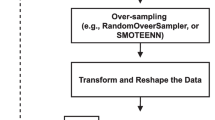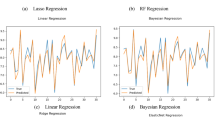Abstract
Educational data mining helps the educational institutions to perform effectively and efficiently by exploiting the data related to all its stakeholders. It can help the at-risk students, develop recommendation systems and alert the students at different levels. It is beneficial to the students, educators and authorities as a whole. Deep learning has gained momentum in various domains especially image processing with a large dataset. We devise a regression model for analyzing the academic performance of the students using deep learning. We have applied regression using deep learning and linear regression on the dataset. For such models with smaller datasets, to tackle the issue of overfitting is critical. Hence, the parameters can be tuned to deal with such issues. The deep learning model records a mean absolute score (mae) of 1.61 and loss 4.7 with the value of k = 3. While the linear regression model yields a loss of 6.7 and mae score of 1.97. The deep learning model outperforms the linear regression model. The model may be successfully extended to other programmes to mine and predict the performance of the learners.







Similar content being viewed by others
Explore related subjects
Discover the latest articles, news and stories from top researchers in related subjects.References
Abhinav, K., Subramanian, V., Dubey, A., Bhat, P., & Venkat, A. D. (2018). LeCoRe: A framework for modeling Learner’s preference. In EDM.
Abu Tair, M. M., & El-Halees, A. M. (2012). Mining educational data to improve students’ performance: A case study. Mining Educational Data to Improve Students’ Performance: A Case Study, 2(2).
Adekitan, A. I., & Salau, O. (2019). The impact of engineering students’ performance in the first three years on their graduation result using educational data mining. Heliyon, 5(2), e01250.
Ahmed, A. B. E. D., & Elaraby, I. S. (2014). Data mining: A prediction for student’s performance using classification method. World Journal of Computer Application and Technology, 2(2), 43–47.
Algarni, A. (2016). Data mining in education. International Journal of Advanced Computer Science and Applications, 7(6), 456–461.
Al-Radaideh, Q. A., Al-Shawakfa, E. M., & Al-Najjar, M. I. (2006, December). Mining student data using decision trees. In International Arab Conference on Information Technology (ACIT’2006), Yarmouk University, Jordan.
Baradwaj, B. K., & Pal, S. (2012). Mining educational data to analyze students’ performance. arXiv preprint arXiv:1201.3417.
Ben-Zadok, G., Hershkovitz, A., Mintz, E., & Nachmias, R. (2009). Examining online learning processes based on log files analysis: A case study. In 5th International Conference on Multimedia and ICT in Education (m-ICTE’09).
Bhise, R. B., Thorat, S. S., & Supekar, A. K. (2013). Importance of data mining in higher education system. IOSR Journal Of Humanities And Social Science (IOSR-JHSS), 6(6), 18–21.
Campbell, C. M., & Cabrera, A. F. (2014). Making the mark: Are grades and deep learning related? Research in Higher Education, 55(5), 494–507.
Carmona, C., Castillo, G., & Millán, E. (2007, September). Discovering student preferences in e-learning. In Proceedings of the international workshop on applying data mining in e-learning (pp. 33–42).
Deng, L. (2014). A tutorial survey of architectures, algorithms, and applications for deep learning. APSIPA Transactions on Signal and Information Processing, 3.
Gadhavi, M., & Patel, C. (2017). Student final grade prediction based on linear regression. Indian Journal of Computer Science and EngineeringIndian Journal of Computer Science and Engineering, 8(3), 274–279.
Goyal, M., & Vohra, R. (2012). Applications of data mining in higher education. International Journal of Computer Science Issues (IJCSI), 9(2), 113.
Guo, B., Zhang, R., Xu, G., Shi, C., & Yang, L. (2015, July). Predicting students performance in educational data mining. In 2015 International Symposium on Educational Technology (ISET) (pp. 125–128). IEEE.
Hernández-Blanco, A., Herrera-Flores, B., Tomás, D., & Navarro-Colorado, B. (2019). A systematic review of deep learning approaches to educational data mining. Complexity, 2019, 1–22.
Hijaz, S. T., & Naqvi, S. R. (2006). Factors affecting students’ performance: A case of private colleges in Bangladesh. Journal of Sociology, 3(1), 44–45.
Hussain, S., Muhsion, Z. F., Salal, Y. K., Theodoru, P., KurtoÄŸlu, F., & Hazarika, G. C. (2019). Prediction model on student performance based on internal assessment using deep learning. International Journal of Emerging Technologies in Learning (iJET), 14(08), 4–22.
Jiawei, H., & Kamber, M. (2011) Data mining: Concepts and techniques, (the Morgan Kaufmann series in data management systems), vol. 2.
Kaur, H., & Bathla, E. G. (2018). Student performance prediction using educational data mining techniques. International Journal on Future Revolution in Computer Science & Communication Engineering, 4(12), 93–97.
Kim, B. H., Vizitei, E., & Ganapathi, V. (2018). GritNet: Student performance prediction with deep learning. arXiv preprint arXiv:1804.07405.
Laxman, S., & Sastry, P. S. (2006). A survey of temporal data mining. Sadhana, 31(2), 173–198.
Mannila, H. (1996, June). Data mining: Machine learning, statistics, and databases. In Proceedings of 8th International Conference on Scientific and Statistical Data Base Management (pp. 2–9). IEEE.
Mardikyan, S., & Badur, B. (2011). Analyzing teaching performance of instructors using data mining techniques. Informatics in Education, 10(2), 245–257.
Mihăescu, M. C. (2011, September). Classification of learners using linear regression. In 2011 Federated Conference on Computer Science and Information Systems (FedCSIS) (pp. 717–721). IEEE.
Montgomery, D. C., Peck, E. A., & Vining, G. G. (2012). Introduction to linear regression analysis (Vol. 821). Hoboken: John Wiley & Sons.
Nichat, A. A., & Raut, D. A. B. (2017). Predicting and analysis of student performance using decision tree technique. International Journal, 5, 7319–7328.
Oyerinde, O. D., & Chia, P. A. (2017). Predicting students’ academic performances–a learning analytics approach using multiple linear regression.
Padhy, N., Mishra, D., & Panigrahi, R. (2012). The survey of data mining applications and feature scope. arXiv preprint arXiv:1211.5723.
Pandey, U. K., & Pal, S. (2011). Data mining: A prediction of performer or underperformer using classification. arXiv preprint arXiv:1104.4163.
Piad, K. C., Dumlao, M., Ballera, M. A., & Ambat, S. C. (2016, July). Predicting IT employability using data mining techniques. In 2016 Third International Conference on Digital Information Processing, Data Mining, and Wireless Communications (DIPDMWC) (pp. 26–30). IEEE.
Priya, K. S., & Kumar, A. S. (2013). Improving the student’s performance using educational data mining. International Journal of Advanced Networking and Applications, 4(4), 1806.
Ramesh, V. A. M. A. N. A. N., Parkavi, P., & Ramar, K. (2013). Predicting student performance: A statistical and data mining approach. International Journal of Computer Applications, 63(8), 35–39.
Romero, C., & Ventura, S. (2010). Educational data mining: A review of the state of the art. IEEE Transactions on Systems, Man, and Cybernetics, Part C (Applications and Reviews), 40(6), 601–618.
Salas-Rueda, R. A. (2016). The impact of usable system for regression analysis in higher education. International Journal of Educational Technology in Higher Education, 13(1), 14.
Shahiri, A. M., & Husain, W. (2015). A review on predicting student's performance using data mining techniques. Procedia Computer Science, 72, 414–422.
Shih, Y. C., Huang, P. R., Hsu, Y. C., & Chen, S. Y. (2012). A complete understanding of disorientation problems in web-based learning. Turkish Online Journal of Educational Technology-TOJET, 11(3), 1–13.
Srimani, P. K., & Patil, M. M. (2014). Regression model for Edu-data in technical education system: A linear approach. In ICT and Critical Infrastructure: Proceedings of the 48th Annual Convention of Computer Society of India, vol II (pp. 785–793). Springer, Cham.
Sultana, J., Rani, M. U., & Farquad, M. A. H. (2009). Student’s performance prediction using deep learning and data mining methods. International Journal of Recent Technology and Engineering, 8(1S4), 1–4.
Suthar, V., & Tarmizi, R. (2010). Effects of students’ beliefs on mathematics and achievement of university students: Regression analysis approach. Journal of social sciences, 6(2), 146–152.
Thomas, E. H., & Galambos, N. (2004). What satisfies students? Mining student-opinion data with regression and decision tree analysis. Research in Higher Education, 45(3), 251–269.
Vora, D. R., & Iyer, K. (2018). EDM–survey of performance factors and algorithms applied. International Journal of Engineering & Technology, 7(2.6), 93–97.
Wang, L., Sy, A., Liu, L., & Piech, C. (2017). Learning to represent student knowledge on programming exercises using deep learning. International Educational Data Mining Society.
Xing, W., & Du, D. (2019). Dropout prediction in MOOCs: Using deep learning for personalized intervention. Journal of Educational Computing Research, 57(3), 547–570.
Yadav, S. K., Bharadwaj, B., & Pal, S. (2012a). Data mining applications: A comparative study for predicting student’s performance. arXiv preprint arXiv:1202.4815.
Yadav, S. K., Bharadwaj, B., & Pal, S. (2012b). Mining education data to predict student’s retention: A comparative study. arXiv preprint arXiv:1203.2987.
Zhou, Q., Quan, W., Zhong, Y., Xiao, W., Mou, C., & Wang, Y. (2018). Predicting high-risk students using internet access logs. Knowledge and Information Systems, 55(2), 393–413.
Availability of data and material
Available on request.
Author information
Authors and Affiliations
Corresponding author
Ethics declarations
Conflicts of interest/competing interests
Not applicable.
Additional information
Publisher’s note
Springer Nature remains neutral with regard to jurisdictional claims in published maps and institutional affiliations.
Rights and permissions
About this article
Cite this article
Hussain, S., Gaftandzhieva, S., Maniruzzaman, M. et al. Regression analysis of student academic performance using deep learning. Educ Inf Technol 26, 783–798 (2021). https://doi.org/10.1007/s10639-020-10241-0
Received:
Accepted:
Published:
Issue Date:
DOI: https://doi.org/10.1007/s10639-020-10241-0




